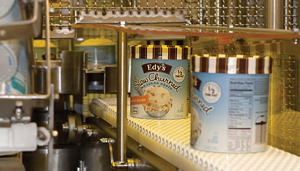
|
| The Edy’s ice cream plant in Fort Wayne, Ind., produces tens of millions of gallons annually, including 48-ounce tubs of Edy’s ice cream, Lil’ Drums flat-top cones and Skinny Cow cones. |
Much of the growth is fueled by ample milk supply and limited competition, said Dale Buuck, vice president business development for Northeast Indiana Regional Partnership. He said that since so much milk is being processed into nonfat and low-fat milk products, there is excess cream. States like Wisconsin or California would use the cream for cheese or butter, but in Indiana “we’re using a lot of that cream for ice cream production,” Buuck said.
The region’s proximity to major markets like Chicago, Detroit, Columbus, Ohio, and Indianapolis combined with a network of rail and highways makes Northeast Indiana a pretty good area for ice cream production. Combine those factors with reasonable electric and natural gas rates, and “It has made it very economical to produce ice cream in Northern Indiana,” Buuck said.
One ice cream processor in the region is Edy’s with a plant in Ft. Wayne. The division of Nestlé’s is focusing on the principles of continuous improvement and in turn it is making a name for itself among other Nestlé plants.
Dairy Foods visited Edy’s in March as part of a tour of food processing and manufacturing plants organized by the Northeast Indiana Regional Partnership in collaboration with Indiana Michigan Power. The trip was intended to highlight Northeast Indiana Regional Partnership’s economic development program and to raise awareness on what’s happening with manufacturing in the region.
In two days Dairy Foods visited six other factories, including Ellison’s Bakery (a producer of ice cream inclusions and bakery items) and Kraft Foods (marshmallow products). Plant managers talked about best practices in food safety and plant safety. (See the related article on page 14.)
The Edy’s ice cream plant has been operating since December 1985. Constant growth has increased staffing to more than 500 workers. The plant produces tens of millions of gallons annually and operates on a 24/7 schedule. It produces 48-ounce tubs of Edy’s ice cream (Grand, Slow Churned); Drumstick round-top ice cream cones; and flat-top cones, like Lil’ Drums and the Skinny Cow ice cream cones.
The plant is recognized as a leading practitioner of continuous improvement, said Plant Manager Sheila Brojek. Nestlé Continuous Excellence, or NCE, is a standardized method of managing improvement across all business functions, including manufacturing. The process begins with foundations of compliance, leadership development and goal alignment. According to Brojek, “These foundational areas support the core missions of NCE, which is to delight the consumer, deliver competitive advantage and excel in compliance.”
For example, goal alignment is a set of methodologies that create aligned objectives from the highest corporate level down through the production operations, Brojek said.
“These methodologies ensure consistent application of several continuous improvement tools and processes followed across any Nestlé factory in the world, and are therefore able to be fully supported from the top down. The process allows everyone in the factory to understand where we are, where we need to go, what the gap is and how to reduce or eliminate it. This engages everyone in the elimination of waste,” she said.
Its success following these principles has put Edy’s Ft. Wayne plant as one of U.S. Nestlé’s highest performing plants, Brojek said. Because they are meeting and beating their goals, this plant is the go-to for pilot programs and sharing of best practices.
“Many of the processes, tools and systems designed here by our people have been determined to be best practices that have been shared and implemented at other sites to support improved inventory control,” said Brojek.




